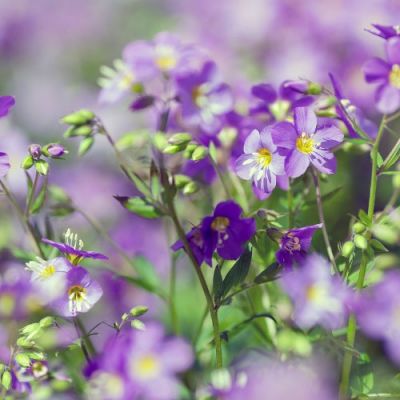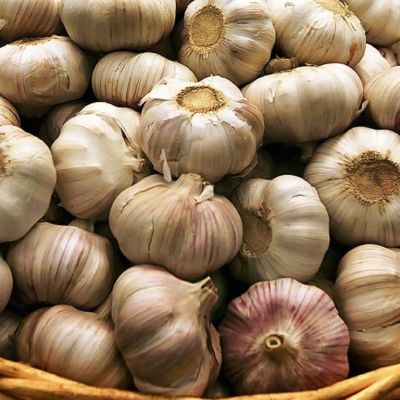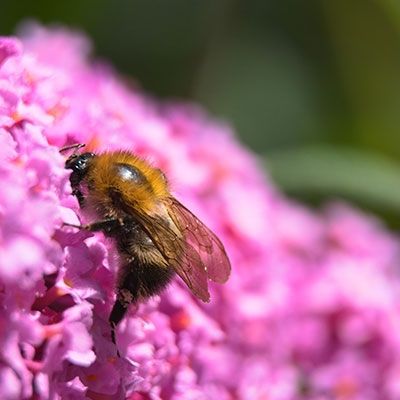05.2022 - May Gardening Tips

How nice it is to see colour returning to the borders once more. It never fails to amaze us how quickly growth re-appears each year. We love May for being just about the best month of the year. The uncertainties of spring and any worries about late frosts are fading, seeds are germinating and the coming weeks will bring us flowers, sunshine, warm rain and lots of gardening joy.
The Last Signs of Winter
It looks like winter may be finally letting go but the chance of frost could still be a distinct possibility. With this in mind we advise you not to put any tender seedlings out yet. Larger plants should be alright if you keep them in pots; the fresh daytime air will toughen them up but you should remain vigilant and keep an eye on the weather, protecting them from frost as necessary. May can often be one of the sunniest months and one of the busiest for gardeners. It's now that everything in the garden really starts to use the extra sunlight to put on an additional growth spurt; unfortunately this does also mean weeds.
If you haven't already started, then we highly recommend that you get on top of all weeds before they get out of control. At this time of year dandelions can become a huge problem if you don't get rid of them. If you haven’t the time to completely uproot them just removing their heads before they go to seed (in a couple of weeks time) will save you so much effort in the long run. Removing daisies and other weeds will also help your lawn and plants flourish.
.jpg)
Fruit
Make sure you net fruit to prevent the birds from stripping fruit trees/bushes clean – some people leave it until the first fruits start to show; we find that birds love developing fruit buds so it's a good idea to protect them as early as possible if you want to maximise your yield.
Strawberry plants can now be planted outdoors in the ground, ready for a delicious crop that can be ready as soon as July, weather dependent of course. If you have never had a go at strawberries, then we highly recommend growing them this year.
You will never taste strawberries as rich and aromatic in flavour as those that are grown in your own garden. You can plant them in the ground, in planters or in a hanging basket.
If you want early strawberries then it's a good idea to put them into the greenhouse now to encourage the growth of early fruit and flowers. If you’re already growing strawberries then feed them now with a high potash feed such as a good tomato fertiliser.
Now is a great time to start harvesting ripe shoots of rhubarb. If you like rhubarb then there are so many delicious recipes available for you to enjoy. You can simply chop it and bake it with honey, stew it with sugar, make a crumble or try combining it with the liquid from a jar of stem ginger and adding whipped cream; the possibilities are endless.

Vegetables
Earth up potatoes, keep drawing the soil up to a ridge every time they grow six inches, this will prevent sunlight getting to the tubers which will turn them green and make them poisonous. It will also increase the yield. Do this every two to three weeks, depending on how fast your potatoes are growing.
Broad bean tips can now be pinched out to prevent encouraging blackfly – be sure to provide adequate support now ready for when they produce pods. You can buy ready made support systems or make your own from garden canes and string. Peas will also now need supporting.
Now is the time to plant runner beans, they’re very easy to plant in seed trays and grow really quickly in the warm soil. Once again be sure to put supports in ready for them as they quickly climb and produce an abundance of delicious beans that are so much tastier than the ones you buy in the supermarket.
If you haven't already, then conditions look good to sow the seeds of beetroot, parsnips, turnips, peas, onions, mangetout and broad bean. Mixed salad, lettuce, watercress and rocket can be sown every two weeks; don’t sow it all at once or you will have so much salad that you won’t know what do with it.
Marrow, courgettes and squash seeds can be planted toward the end of this month.
Pests to Look Out For
Lily beetles are now on the move; easily spotted due to their bright red coloured backs. Adults and larvae can damage lilies and fritillaries by defoliation. We've also noticed that whitefly and red spidermite are slowly accumulating in numbers.
Check the underside of leaves on shrubs , perennials and roses regularly for greenfly and black fly infestation. You can crush them or shake them off, if infestations are really bad, then a mixture of soapy water sprayed onto leaves can help. Alternatively you can introduce biological methods of pest control or buy a greenfly killer. If you’re unsure, then pop in and ask a member of staff for some advice.
Repelling Unwanted Insects
There are lots of ways to naturally repel unwanted insects from different areas of your garden.
- Planting onions and leeks next to carrots will deter carrot fly.
- French Marigolds will ward off greenfly and blackfly - plant them next to your tomatoes.
- Ants can sometimes become a problem with plants that are planted directly into the ground. Plant peppermint, bay leaf or garlic to deter them.
- Mice can be deterred by planting an elder shrub.
- Snails and slugs can be caught in a beer trap - a little sip and they become drunk and drown.
- Nasturtiums will deter aphids.
Encouraging Beneficial Insects
Buddleia, Achillea and flowering herbs such as Dill, Rosemary and Lavender planted throughout your greenhouse will attract pest-devouring ladybirds, lacewings and hoverflies.
You can keep these beneficial insects in your garden by installing a bug box. Bug boxes can house spiders, ladybirds, lacewings, bees and more which can all be beneficial to your garden. Give nature a helping hand this month by making your own bug box or buy a ready made one. Make sure you install it in a sheltered spot that's not too hidden away.
Gardening Jobs for This Month
- Keep on top of weeds, carry on spring cleaning, driveways, patios etc.
- Watch the weather forecast and look out for frosts, protect vulnerable plants by bringing them in at night or keeping them in a heated greenhouse or shed.
- Water containers every day. Water the garden thoroughly once or twice a week depending on the weather, if it's really hot and dry or windy then the garden will need to be watered more often.
- As soon as early flowering Clematis have flowered prune them back to control their size.
- Gladioli can now be planted along with the outdoor sowing of hardy annual flowers.
- Take cuttings from the new growth of Dahlias and Fuchsias.
- Remember to ventilate greenhouses on warm sunny days by opening the door or windows – it’s equally important to heat them or bring plants inside when frost is forecast.
- Don’t put out tender bedding plants until the middle or towards the end of the month. Be prepared to cover with fleece if necessary.
- Hellebore seeds can be collected, placed in an envelope and stored in a dry place.
- Wash any dust off the foliage of houseplants.
- Rake out dead grass from lawns. Keep on top of lawn mowing. If you’re wanting to sow lawn seed to create a new lawn then this month will likely be the last chance you will have this year.
- Tidy up hedges but make sure you check for bird's nests first.
- As the soil now starts to warm up you will notice that things have started to grow. Add fertiliser before covering with mulch especially in the vegetable patch, containers and borders.





